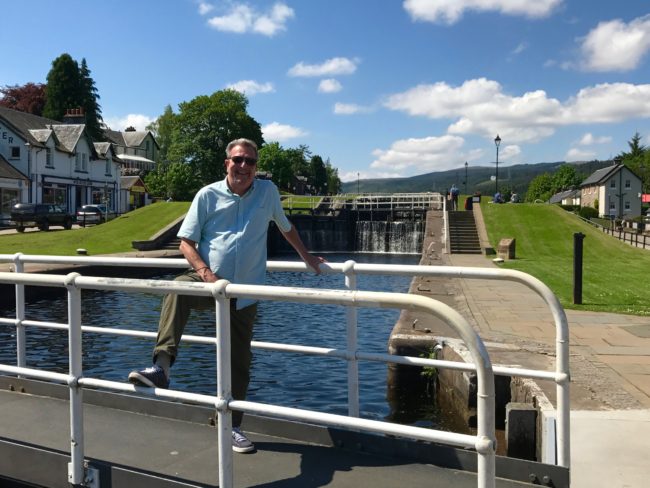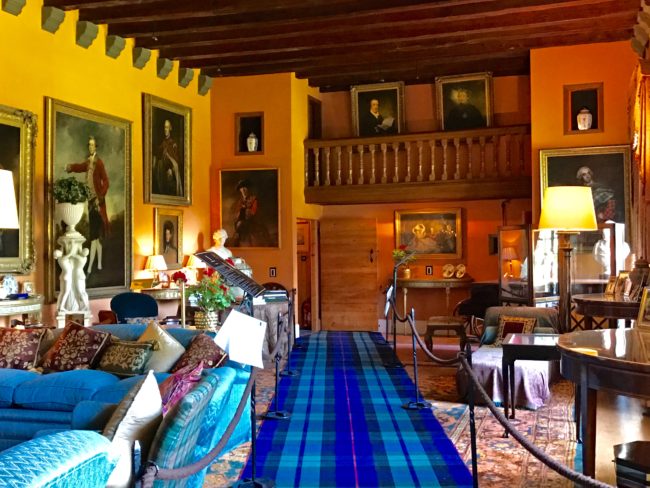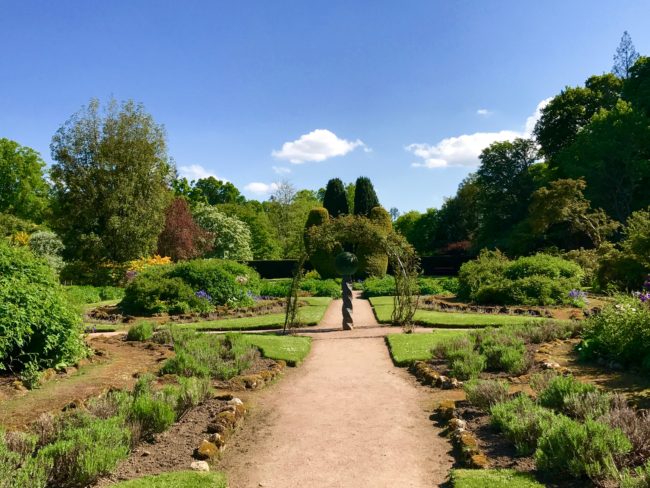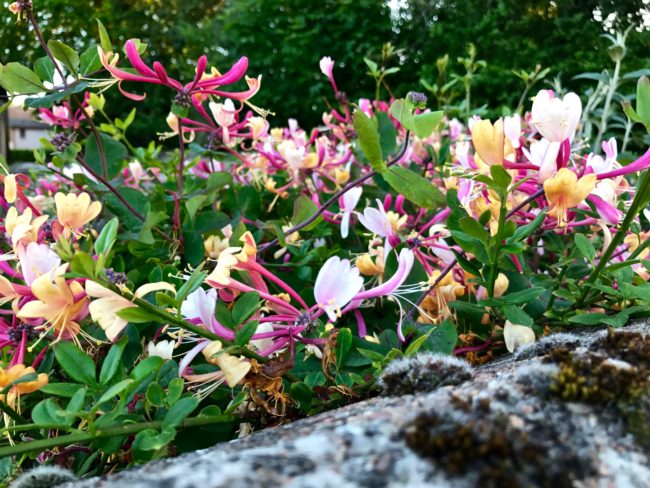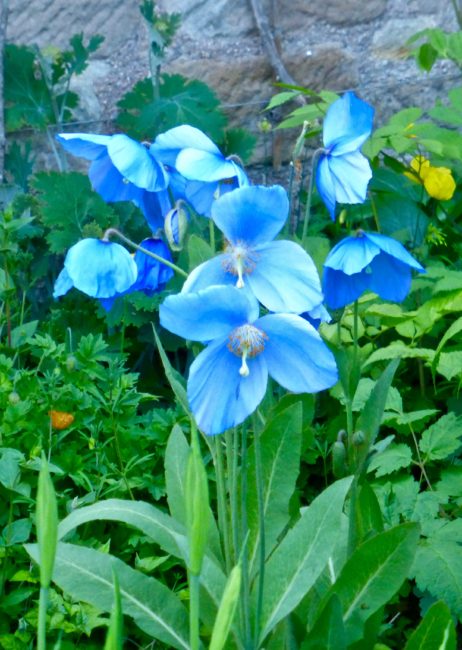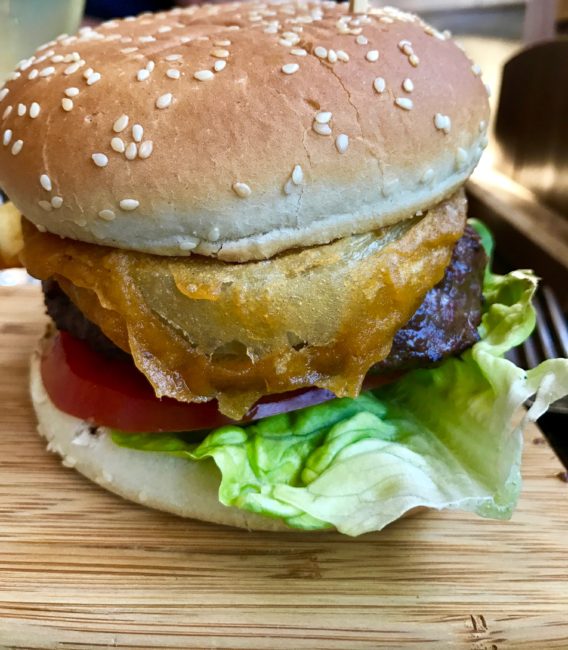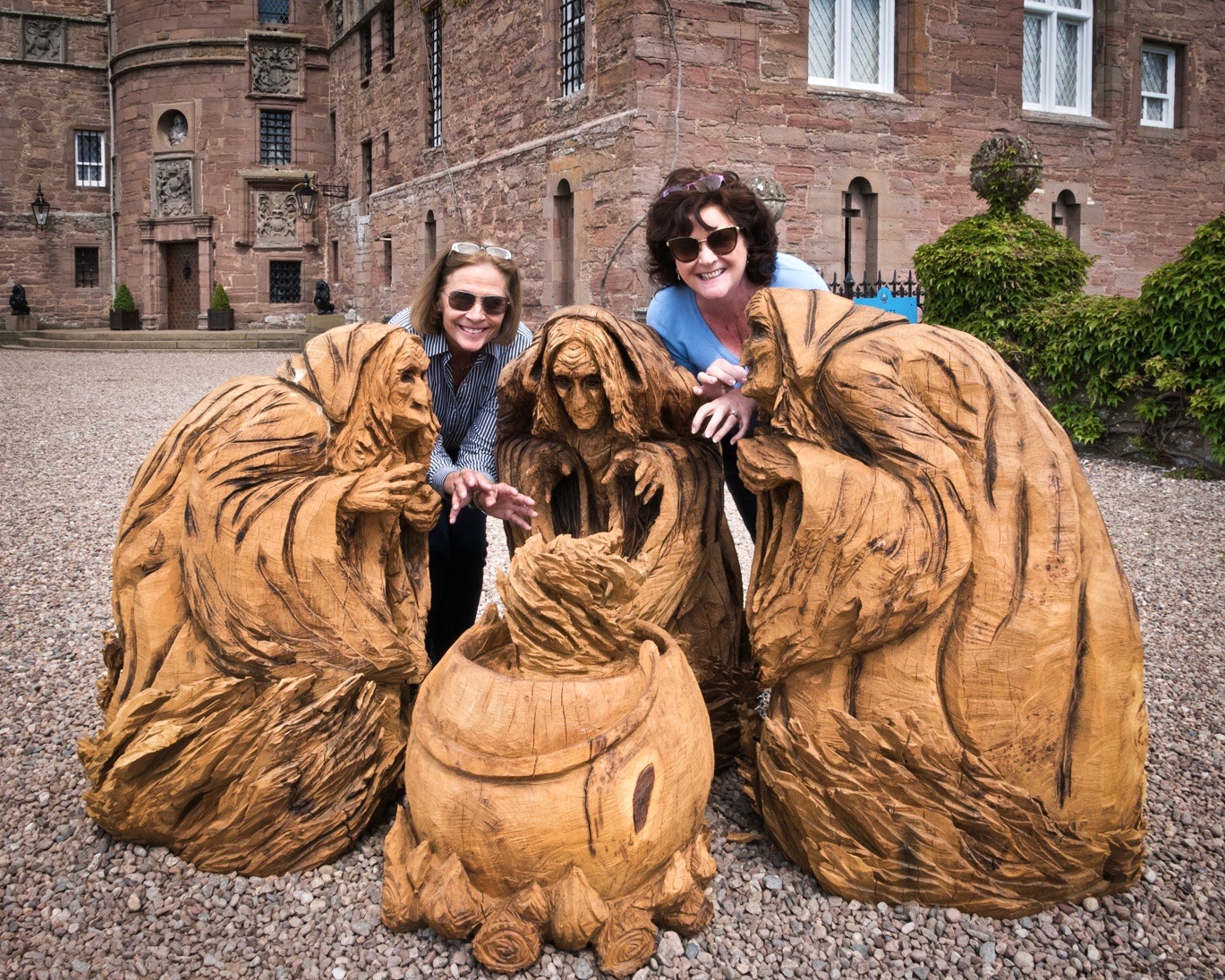
Chapter Ten – Touring Isle Of Skye
August 23, 2017
Chapter Twelve – Elgin Cathedral To Dunnottar Castle: Our Day In Ruins
September 6, 2017MaiTaiTom Gets The Royal Treatment…Two Weeks Exploring London and Scotland
 Chapter Eleven – Isle Of Skye To Nairn: A Tale Of Three Castles
Chapter Eleven – Isle Of Skye To Nairn: A Tale Of Three Castles
DAY TWELVE: Everybody Must Get Stoned, Come On Eilean, Our Summer House, Monstrous Loch, Lunch By The Locks, Medieval Times, Homey Castle, More Magnificent Gardens, So That’s The Name Of That Yellow Tree, Mind Your Manors, Did You Bring Shorts, A Day At The Beach and Where’s Dick Clark?
It was tough to leave the spectacular surroundings at the Cuillin Hills Hotel…
 …but it was sadly time to say “bye” to Skye and colorful Portree. We did have a hearty breakfast because we’d be traveling across Scotland in search of castles.
…but it was sadly time to say “bye” to Skye and colorful Portree. We did have a hearty breakfast because we’d be traveling across Scotland in search of castles.
 Before we hit our first big ticket item, we stopped one last time on the Isle of Skye to check out The “Old” Sligachan Bridge. There’s a local legend that if you dip your face in the water by The “Old” Sligachan Bridge, you’ll be rewarded with eternal beauty. After looking at myself in the mirror back at the hotel, I concluded I was beyond help.
Before we hit our first big ticket item, we stopped one last time on the Isle of Skye to check out The “Old” Sligachan Bridge. There’s a local legend that if you dip your face in the water by The “Old” Sligachan Bridge, you’ll be rewarded with eternal beauty. After looking at myself in the mirror back at the hotel, I concluded I was beyond help.
 The stone bridge, built in the 1820s goes over the River Sligachan. There were lots of folks milling about, so a good photo of the bridge was pretty near impossible.
The stone bridge, built in the 1820s goes over the River Sligachan. There were lots of folks milling about, so a good photo of the bridge was pretty near impossible.
 The surrounding countryside was, however, quite photogenic.
The surrounding countryside was, however, quite photogenic.
 Hopping back in the car, Tracy snapped a final Skye photo…
Hopping back in the car, Tracy snapped a final Skye photo…
 …and soon we crossed The Skye Bridge. The bridge opened in 1995 amid controversy over the toll (in 2004, for instance, a round trip cost drivers £11.40). There were mass protests, people were arrested and fined for not paying the toll, until, in December of 2004, the bridge became toll-free. Today, all bridges in Scotland have no tolls (or trolls, I assume).
…and soon we crossed The Skye Bridge. The bridge opened in 1995 amid controversy over the toll (in 2004, for instance, a round trip cost drivers £11.40). There were mass protests, people were arrested and fined for not paying the toll, until, in December of 2004, the bridge became toll-free. Today, all bridges in Scotland have no tolls (or trolls, I assume).
As we reached the other side…
 … it was as if someone had erased all the clouds we’d seen the past few days. In about 15 minutes, we stepped out of the car at beautiful Eilean Donan Castle, and the temperature was already 20 degrees warmer than it had been at the Sligachan Bridge.
… it was as if someone had erased all the clouds we’d seen the past few days. In about 15 minutes, we stepped out of the car at beautiful Eilean Donan Castle, and the temperature was already 20 degrees warmer than it had been at the Sligachan Bridge.
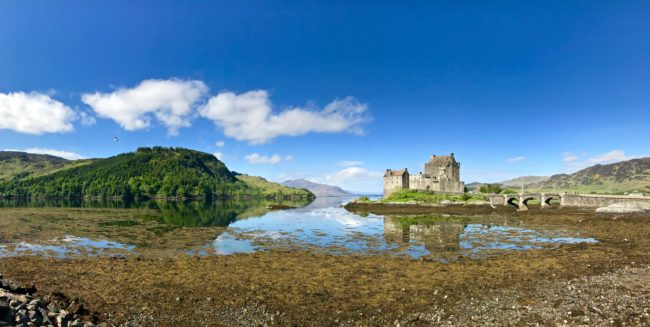 We had heard about the incredible views, and they lived up to the advanced hype.
We had heard about the incredible views, and they lived up to the advanced hype.
 Eilean Donan Castle is a true Scottish icon located on a tiny island. Back in 634 AD, Bishop Donan chose this peaceful place to create a monastic cell (no cell phones, however). The first castle here was constructed in the 13th century. The castle has been enlarged and downsized through the years.
Eilean Donan Castle is a true Scottish icon located on a tiny island. Back in 634 AD, Bishop Donan chose this peaceful place to create a monastic cell (no cell phones, however). The first castle here was constructed in the 13th century. The castle has been enlarged and downsized through the years.
The four of us walked to different vantage points to take photos, and the different views were stunning.
 Back in the car, we drove toward Fort Augustus where we planned to eat lunch. Tracy spent her time taking more photos out of the car.
Back in the car, we drove toward Fort Augustus where we planned to eat lunch. Tracy spent her time taking more photos out of the car.
DIGRESSION: We had been told by many to expect delays on Scottish roads. Luckily for us, in our seven days of crisscrossing Scotland, we never encountered traffic (we didn’t even see that many cars…they must have known we were coming), get stuck behind a slow lorrie and the sheep must have been off playing, because we never saw one on the road.
On the way to Fort Augustus, I spotted a sign for Invermoriston, and thanks to my over planning for this trip, I remembered there was something to see at the River Moriston. Stopping at a car park, we wandered through a gate and started on a hike in the woods.
I told the gang we were headed for The Summer House. “I didn’t know you had a summer house here,” Mary said.
 Actually, J.M. Barrie’s (the Scottish novelist known for creating Peter Pan) Summer House (or Summerhouse) is a small stone house, which is a great location to snap a few photos of the Falls of Invermoriston. (Photo below right is from the website Travels With Shep.)
Actually, J.M. Barrie’s (the Scottish novelist known for creating Peter Pan) Summer House (or Summerhouse) is a small stone house, which is a great location to snap a few photos of the Falls of Invermoriston. (Photo below right is from the website Travels With Shep.)
Actually, Barrie lived in a larger house in the summer of 1910. Supposedly this was designed to shelter house guests as they watched salmon migrating upstream. I hear that Barrie and his guests enjoyed salmon enchanted evenings at this little dwelling. It only made sense for me (who has never grown up) and the others to take photos from here.
 It was dark in there, but fortunately I didn’t run into a pirate with a hook. We also witnessed a well-known bridge in the distance. The Telford Bridge (named for Thomas Telford… architect, stonemason and canal builder among other things) was constructed in 1813. It has since been replaced by a new bridge. Telford’s bridge is the one with two arches. By the way, Telford’s nickname was “The Colossus of Roads,” and, as you know, I can’t pass up a pun, even if it’s not mine. Our little hike in the woods was certainly a worthwhile diversion.
It was dark in there, but fortunately I didn’t run into a pirate with a hook. We also witnessed a well-known bridge in the distance. The Telford Bridge (named for Thomas Telford… architect, stonemason and canal builder among other things) was constructed in 1813. It has since been replaced by a new bridge. Telford’s bridge is the one with two arches. By the way, Telford’s nickname was “The Colossus of Roads,” and, as you know, I can’t pass up a pun, even if it’s not mine. Our little hike in the woods was certainly a worthwhile diversion.
 Driving toward Fort Augustus, there was an opening in the trees, and Tracy yelled for Kim to stop the car. “I think I saw a monster.” She leaped from the car (which was fortunately stopped) and snapped these photos of Loch Ness. Unfortunately, “Nessie” had disappeared once again.
Driving toward Fort Augustus, there was an opening in the trees, and Tracy yelled for Kim to stop the car. “I think I saw a monster.” She leaped from the car (which was fortunately stopped) and snapped these photos of Loch Ness. Unfortunately, “Nessie” had disappeared once again.
It was on to Fort Augustus, whose name is derived from a fort that was constructed following the defeat of the 1715 Jacobite uprising. These series of locks were quite impressive.
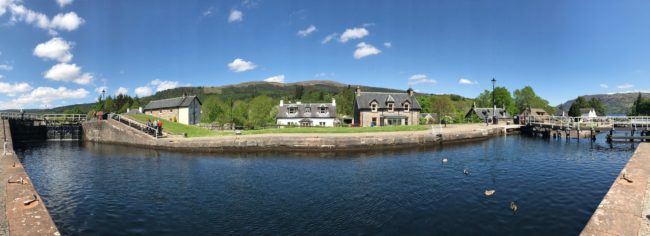 Old Thomas Telford strikes again…he’s the guy who also designed the lock system, which is part of the 60-mile Caledonian Canal that links Inverness to Fort William. By now, the temperature was nearing 80 degrees…more than 30 degrees warmer than we were the previous day when we were bundled up on the Isle Of Skye.
Old Thomas Telford strikes again…he’s the guy who also designed the lock system, which is part of the 60-mile Caledonian Canal that links Inverness to Fort William. By now, the temperature was nearing 80 degrees…more than 30 degrees warmer than we were the previous day when we were bundled up on the Isle Of Skye.
These locks were also a short cut for merchant shippers between the east and west coasts of Scotland, making it harder for those pesky pirates to get to them (the first time I have ever used two pirate references in a trip report).
We stopped at a butcher a shop and ordered some sandwiches that we munched on outside. They were just ok. If you go to Fort Augustus, you might try the fish & chips at The Lock Inn (they looked really good), which features outside seating along the canal.
 Finally, we ran into the Loch Ness Monster (the monster is on the left). Threatening, it wasn’t.
Finally, we ran into the Loch Ness Monster (the monster is on the left). Threatening, it wasn’t.
We hung out here for a while, but we still had two more castles to visit on this sunny and now very hot afternoon.
On a headland overlooking Loch Ness, our journey next brought us to Urquhart Castle, one of Scotland’s largest.
 It’s quite dramatic when you get your first glimpse of Urquhart (free on the Explorer Pass). The ruins with a backdrop of Loch Ness is nothing less than spectacular.
It’s quite dramatic when you get your first glimpse of Urquhart (free on the Explorer Pass). The ruins with a backdrop of Loch Ness is nothing less than spectacular.
 During the Wars of Independence this property changed hands on many occasions between the Scots and English.
During the Wars of Independence this property changed hands on many occasions between the Scots and English.
 After navigating down a multitude of stairs and before reaching the castle, we passed by an early weapon of mass destruction…the trebuchet. The medieval, mobile contraption launched projectiles such as large stones. It sometimes used corpses as weapons (even Monty Python didn’t think of that).
After navigating down a multitude of stairs and before reaching the castle, we passed by an early weapon of mass destruction…the trebuchet. The medieval, mobile contraption launched projectiles such as large stones. It sometimes used corpses as weapons (even Monty Python didn’t think of that).
We walked and climbed around the ruins …
… and enjoyed the views over Loch Ness.
With the beautiful, blue skies, Urquhart shined, but yet another castle was calling our name.
A little less than an hour from Urquhart Castle stands Cawdor Castle (£11 and £10 for seniors). Located on the east bank of the valley of the Allt Dearg about five miles southwest of Nairn, Cawdor’s interior has been renovated. The staff here was very friendly and informative, and the woman at the front desk was a hoot (she has worked here for 27 years).
I had read such interesting tidbits as, “William, 3rd Thane of Cawdor, decided to build a replacement castle on a less marshy site than its predecessor. In about 1370 he set out to locate the site for a new castle . Following instructions received in a dream he loaded panniers of gold on the back of a donkey, which he then followed as it roamed across his lands for a day. When evening came the donkey lay to rest under a tree on a higher and more rocky site close to the steep-sided valley of the Allt Dearg.” Thus, by resting his ass, William found a site for his castle.
There’s a shield over the main doorway, and I suggest you watch your head while entering.
In no particular order, we visited the Drawing Room, which dates from the 16th century and has been frequently remodeled. At one end of the room there’s a minstrel’s gallery. The walls are filled to the brim with portraits, and there is also a grand piano. This is certainly a castle that has that “lived in” quality.
The Tower Room includes a Louis XV Writing Desk. It’s a good place in winter, because the large fireplace makes this the warmest room in the castle.
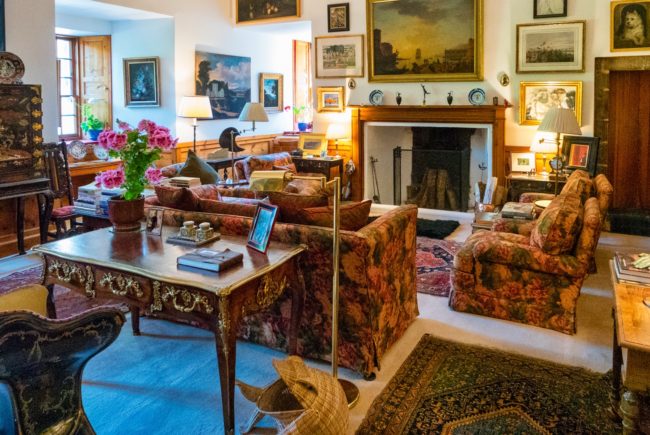 This pillow lets you know who’s in charge. That’s a fact, Jack!
This pillow lets you know who’s in charge. That’s a fact, Jack!
 The Tapestry Bedroom’ showcases a 17th-century four poster bed with red velvet drapes. It was the “marriage bed” of Sir Hugh Campbell and Lady Henrietta Stuart back in the 1660s. The Flemish tapestries were purchased in the 1680s.
The Tapestry Bedroom’ showcases a 17th-century four poster bed with red velvet drapes. It was the “marriage bed” of Sir Hugh Campbell and Lady Henrietta Stuart back in the 1660s. The Flemish tapestries were purchased in the 1680s.
 Next, we were in the pink. The Pink Bedroom’s tapestries are from the early 1680s, and they are part of the Don Quixote collection in the dining room. Pink’s music was not playing.
Next, we were in the pink. The Pink Bedroom’s tapestries are from the early 1680s, and they are part of the Don Quixote collection in the dining room. Pink’s music was not playing.
 The Woodcock Room acquired its name from a painting of a woodcock in the room. The room dates from the 17th century, and if you like ivy, you’ll love the wallpaper.
The Woodcock Room acquired its name from a painting of a woodcock in the room. The room dates from the 17th century, and if you like ivy, you’ll love the wallpaper.
The Dining Room has a stone fireplace that was installed in 1671. The installation had some problems according to a diary. “…This day there did fallout a remarkable accident, never to be forgotten. The drawbridge at Cawdor fell, carrying in a great stone, and with it 24 men, and the Laird himself. Some were hurt…”
The Tartan Passage contains old needlework, a model of the sailing ship Victory and a weary Maitaitom.
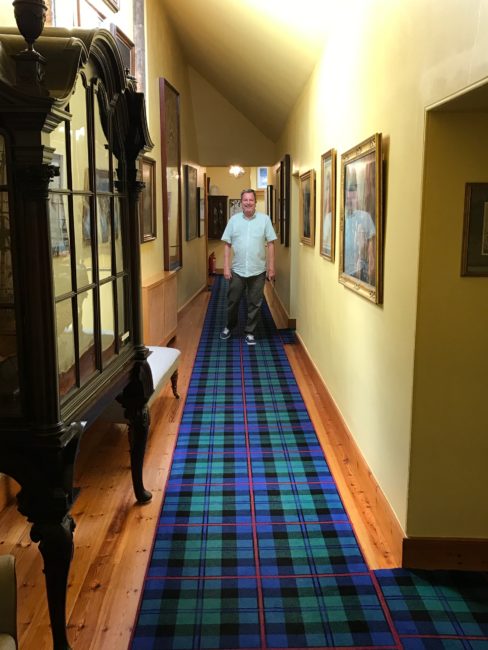 Finally we hit The Kitchen, which was in use for three centuries between 1640 and 1938.
Finally we hit The Kitchen, which was in use for three centuries between 1640 and 1938.
 Sadly, The Thorn Tree Room was not open. Legend has it that “One oddity of Cawdor Castle was that it was built around the hawthorn tree under which the donkey rested. This subsequently became a feature of part of the cellar, known ever since as ‘The Hawthorn Room.’ Supposedly the tree has magical qualities which have on more than one occasion saved the castle from disaster. Modern scientific analysis revealed that the tree died in about 1372, presumably as a result of being deprived of light following the building of the castle: and that it is a holly and not a hawthorn.” (Photo from Cawdor Castle website.)
Sadly, The Thorn Tree Room was not open. Legend has it that “One oddity of Cawdor Castle was that it was built around the hawthorn tree under which the donkey rested. This subsequently became a feature of part of the cellar, known ever since as ‘The Hawthorn Room.’ Supposedly the tree has magical qualities which have on more than one occasion saved the castle from disaster. Modern scientific analysis revealed that the tree died in about 1372, presumably as a result of being deprived of light following the building of the castle: and that it is a holly and not a hawthorn.” (Photo from Cawdor Castle website.)
 Oh well. It was time to visit the gardens that, upon further review, rival the beautiful gardens we had visited at Dunvegan Castle on Isle of Skye. Tracy can never say I gave her short shrift on gorgeous gardens this time.
Oh well. It was time to visit the gardens that, upon further review, rival the beautiful gardens we had visited at Dunvegan Castle on Isle of Skye. Tracy can never say I gave her short shrift on gorgeous gardens this time.
Cawdor Castle has three gardens: the Walled Garden, the Flower Garden and the Wild Garden.
We had seen these yellow trees everywhere yet had no clue what heck they were called. I scurried back to the reception area, and after putting their three collective heads together, the staff was unanimous in in their determination that they were called Laburnum (aka Golden Chain or Golden Rain).
Bumping into one of the four full-time gardeners a short time later, he confirmed their answer.
 The four of us paid our respects at the grave of the Jolly Green Giant.
The four of us paid our respects at the grave of the Jolly Green Giant.
 Flowers were bursting with color.
Flowers were bursting with color.
The bees found the Flower Garden a good spot for a late afternoon snack. Pollinate this!
By now temps were in the mid 80s, and as we toured the gardens …
… sweat was accumulating. Wasn’t it just 24 hours age we were in a fog?
Views of the castle …
… are actually best from Cawdor’s expansive gardens.
 We probably walked around here for about 30 – 45 minutes …
We probably walked around here for about 30 – 45 minutes …
 … but at some point it was time to hit the road. We all really enjoyed Cawdor Castle, and if you’re in the vicinity pay a visit.
… but at some point it was time to hit the road. We all really enjoyed Cawdor Castle, and if you’re in the vicinity pay a visit.
It was only a 15-minute drive to our hotel in Nairn. We turned down a long tree-lined driveway, and we came upon a manor that, from the outside, looked like something out of the movies. The Newton Hotel is located on a 21-acre estate overlooking the Moray Firth. I was surprised, however, that there were no figs at the Newton.
Inside, the hallways were spacious, and the staircase grand.
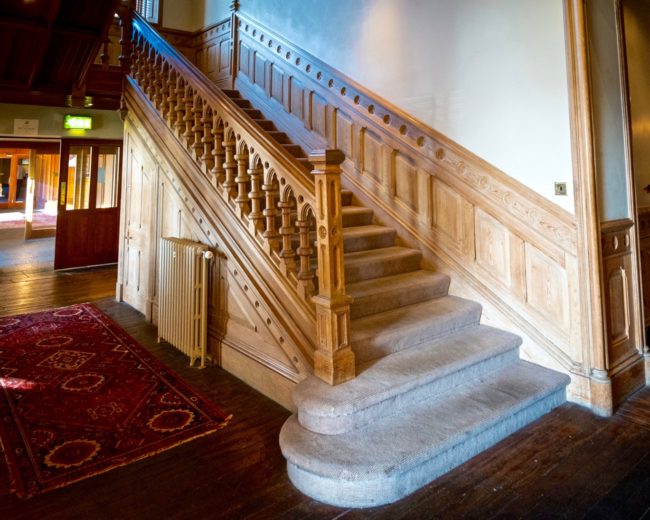 The downside? Rooms at the Newton are rather frayed and worn. If somebody could put a few bucks into this place it could be a jewel. The bar was nice, and we enjoyed a cold one before heading to where most Californians like to go on a hot day … at the beach!
The downside? Rooms at the Newton are rather frayed and worn. If somebody could put a few bucks into this place it could be a jewel. The bar was nice, and we enjoyed a cold one before heading to where most Californians like to go on a hot day … at the beach!
 Due to my affinity for Dick Clark, I had booked the Bandstand for our 7:30 dinner. We left early to check out the area, and very near the Bandstand stood a monument…a mysterious monument located on a grassy area called The Links. According to its plaque. “The monument known as the Toorie appeared overnight in August 1859. Local legend has it that the structure was erected overnight by apprentice masons working all night to Dr. Grigor’s plan, using stones from the old riverside Kirk, during a local dispute a year later the monument was wrecked, but was restored to it’s present form by the local council.” Who is Dr. Grigor? What is a Toorie? No one seems to know.
Due to my affinity for Dick Clark, I had booked the Bandstand for our 7:30 dinner. We left early to check out the area, and very near the Bandstand stood a monument…a mysterious monument located on a grassy area called The Links. According to its plaque. “The monument known as the Toorie appeared overnight in August 1859. Local legend has it that the structure was erected overnight by apprentice masons working all night to Dr. Grigor’s plan, using stones from the old riverside Kirk, during a local dispute a year later the monument was wrecked, but was restored to it’s present form by the local council.” Who is Dr. Grigor? What is a Toorie? No one seems to know.
Also nearby was The Wallace Bandstand, “constructed in 1884 in honor of John Wallace, an eminent citizen of Nairn who became a pioneer in the Victoria colony in Australia.”
 Now it was time to check out another Bandstand, The Bandstand Bar & Grill. We sat at a window seat with a view of Nairn Beach and Moray Firth. Firth things firth, we ordered some libations.
Now it was time to check out another Bandstand, The Bandstand Bar & Grill. We sat at a window seat with a view of Nairn Beach and Moray Firth. Firth things firth, we ordered some libations.
For dinner, Kim went for the Steak Pie in Cairngorm ale gravy with short crust pastry, root vegetables and chips (£10.75).
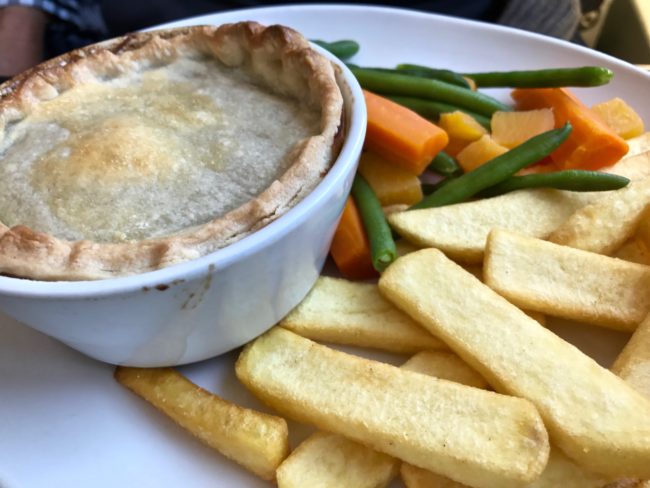 Mary had a Bandstand Burger with burger relish, beef tomato and iceberg lettuce in a bun with battered onion rings, fresh coleslaw and chips (£10.75).
Mary had a Bandstand Burger with burger relish, beef tomato and iceberg lettuce in a bun with battered onion rings, fresh coleslaw and chips (£10.75).
 Tracy decided on a Tempura Prawn Salad to start and ordered the hamburger.
Tracy decided on a Tempura Prawn Salad to start and ordered the hamburger.
Finally, my choice was a very good 8 oz. Sirloin (Scottish beef is good, although I met some future victims the following evening, and I felt some remorse). As you can see, it came with both onion rings and fries. Yeah, baby!
 Not satisfied with those 1,000 calories, for dessert I dug into my Sticky Toffee Pudding with warm butterscotch sauce and fresh pouring cream (£5.45). The crew wasn’t hungry, so I was able to devour this without any assistance … thankfully.
Not satisfied with those 1,000 calories, for dessert I dug into my Sticky Toffee Pudding with warm butterscotch sauce and fresh pouring cream (£5.45). The crew wasn’t hungry, so I was able to devour this without any assistance … thankfully.
Our taxi driver remarked on the way back to the Newton that the warm weather was quite unusual for these parts, however he did say there had been a terrible lack of precipitation during the winter. We had told him how much colder it had been on Isle of Skye, and he replied, “When you come to Scotland, you have to pack for all four seasons!”
 Back at the hotel, we had a glass of wine and called it a night.
Back at the hotel, we had a glass of wine and called it a night.
 The trip was winding down…we only had one weekend remaining. Our day tomorrow would take us to some cathedral ruins, a cute little garden, a Whisky Distillery, yet another famous old bridge, a castle once occupied by a governor of New York and culminated with a visit to a dramatic castle on a cliff (left). The one million stairs back up nearly killed me. We’d stay at a remote (and very nice) b&b in the countryside where I met some of Scotland’s future dinners, and we would dine at a charming restaurant with a sea view. No rest for the weary!
The trip was winding down…we only had one weekend remaining. Our day tomorrow would take us to some cathedral ruins, a cute little garden, a Whisky Distillery, yet another famous old bridge, a castle once occupied by a governor of New York and culminated with a visit to a dramatic castle on a cliff (left). The one million stairs back up nearly killed me. We’d stay at a remote (and very nice) b&b in the countryside where I met some of Scotland’s future dinners, and we would dine at a charming restaurant with a sea view. No rest for the weary!
Next: DAY THIRTEEN – “Lantern Of The North”, A Garden of Biblical Proportions, No Whisky For You, Too Early For A Picnic, Not Lichen This Road, A Governor Lived Here, How Many Steps To The Bottom?, Did I Lock The Car?, King For A Day, What Goes Down Must (Unfortunately) Come Up, Steer Clear, Catterline Cuisine and The Sun Begins To Set On Our Trip
















